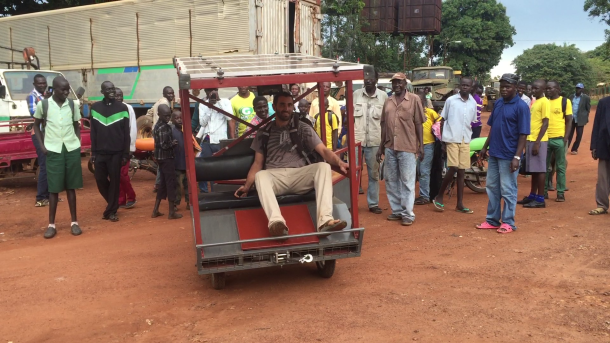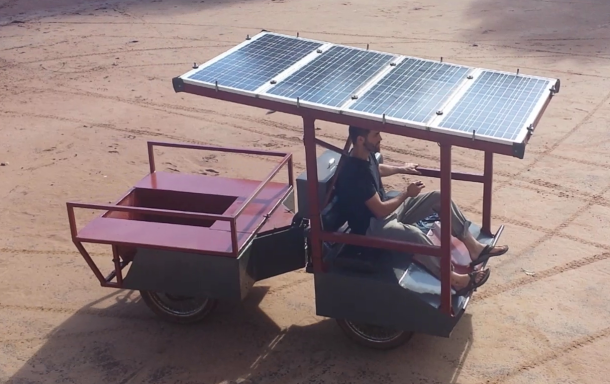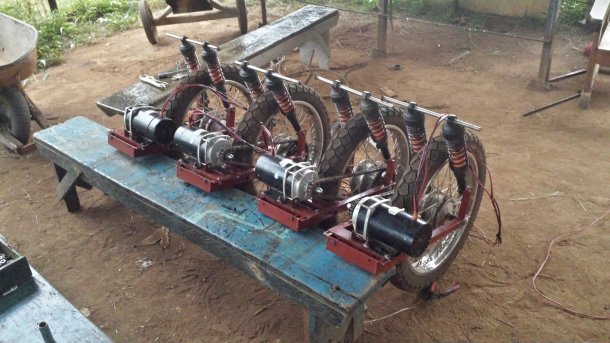Transportation is major issue in the developing world due to its lacking physical infrastructure, and unfortunately, off-road SUVs are outside the means of the average person. In an effort to make them more accessible to everyone, Maker Chris Low built a solar-powered utility vehicle capable of battling harsh environments and rugged terrain.

Atmel: What is the Light Electric Utility Vehicle?
Chris Low: The Light Electric Utility Vehicle, which I am now calling the Solar Utility Vehicle (or SUV), is a solar-powered utility vehicle that has been made specifically for the conditions in the developing world. It is designed to be fully off grid, and charge itself from an array of four 95W solar panels that form a canopy over the vehicle. It has a portable power bank so that people can drive somewhere and have power available to them. It is also meant to be robust enough to handle the rough roads in a developing world context.
Atmel: How did you come to the idea for the SUV? Moreover, what inspired you to enter the contest with your project?
CL: This is an idea I have been thinking about for a few years now. I have been working in Africa primarily South Sudan since 2008 back when it was still part of Sudan. In that time, I have had to work on a lot of broken vehicles that just couldn’t cope with the conditions, and finding spare parts can be a nightmare. Few people realize that an all-electric drivetrain is actually much simpler mechanically than an ICE and has much fewer moving parts. I have been looking at making a small electric skid steer, but found that an articulating design is much more efficient and puts much less stress on components. I love small vehicles, and can see a huge potential market for something in this size throughout the developing world. There are some similarly sized three-wheel vehicles available here, but after owning one and always trying to fix it and not roll it, I knew there was a better solution for this environment.
I built this project because I had a use for a vehicle like this in the work that I do, and there was nothing available. I also spend a lot of time working with local welders in South Sudan, and I know if I could make kits and create easily understandable plans they could manufacture these vehicles locally; which would create jobs in a place that desperately needs them. I would have done this project anyways, but since I am an avid Hackaday reader I happily put this project in the competition, which I hope spreads the idea and inspires people to improve upon the idea.

Atmel: In line with the Hackaday Prize theme, how are you hoping the Solar Utility Vehicle changes the world? What’s the mission?
CL: Like I said before the mission is to provide people in poor areas of the world with an affordable tool which can benefit there lives. A locally manufactured vehicle also has the advantage of benefiting the local economy. I think there is also a great opportunity now for the developing world to develop using much more sustainable energy sources. Not only doesn’t this vehicle need petroleum-based products, it also doesn’t require expensive grid infrastructure. It is ready to work no matter how remote the location.
Atmel: What’s different about it? What’s your vision for the next five years? Where do you see the vehicle going or what/who would you hope will pick up the project and use it?
CL: I think designing a practical solar vehicle is a bit different. Most of the examples I have seen of solar vehicles often don’t have a practical use in mind. Solar power for a utility vehicle makes a lot of sense, because they are often used for brief periods with lots of downtime in between to recharge. It is also incredible useful to have mobile power without the use of a generator. The body design with an articulating frame and differential motor control is also a bit different.
I already have a pretty extensive redesign in mind. Now that I have proved the concept, I would like to try a version using LiFePO4 batteries and hub motors with a more traditional steering design. I am always trying to improve things and make it simpler, but I would also like to push the efficiency boundaries as well on the next iteration.
I would love to see anyone make one of these, but I am a bit careful as well. While I believe this vehicle is about as inexpensive as it can be considering the technology involved, I also realize that at about USD $3,500 it is a huge investment for someone in a poor area. I have had a lot of offers to buy the vehicle here, but I really want to make sure everything is rock solid before people spend so much of their money on something.

Atmel: As we know, the Maker Movement has opened the door for everyone from hobbyists to tech enthusiasts to hardcore engineers to tinker around. What’s your personal background?
CL: I am certainly a beneficiary of the Maker Movement. My degree is actually in construction management, but most of my skillset comes from growing up on a farm and loving to try new things. I grew up doing a lot of electrical wiring, but really didn’t get into electronics until later in life. I started by building solar panels that I was using in South Sudan, but that quickly opened up into a lot of other things. I have done quite a few different alternative energy projects in South Sudan, and really love making these technologies accessible to people without costing a fortune.
I love that we have such an amazing amount of information so readily available to us now through the Internet. Anything form in depth analysis and feedback from strangers on forums, to free courses from places like MIT. We are really blessed in a way that no other generation has been.
Atmel: What are some of the core pieces of hardware embedded?
CL: Most of the brain work on the vehicle come from a pair of Arduino Pro Minis (ATmega328). One does monitoring of different current and temperature sensors and display that to an LCD screen. The other reads a Wii Nunchuck and a potentiometer at the point of articulations, and runs a PID loop which outputs to a pair of Dimension Engineering Sabertooth 2X60 motor controllers which run four 24V 650W DC gear motors.
Atmel: What hardware products or projects are you also building at the moment?
CL: My current project is very hardware centered. I just took the SUV up to a very remote refugee camp on the border to Sudan in the back of a very old Russian cargo plane. I am using the power from the SUV to cut doors and windows into an old shipping container that I am turning into a house. We are hoping to move up here early next year. I’ll be installing solar power, and be welding up furniture and other things we will need. I am also working on a BMS system for the LiFePO4 batteries for cell balancing, which uses a relay board and boost converter to run certain loads only off of the cell with the highest voltage.

Atmel: Why pick Atmel (and Arduino) chips?
CL: I think as a non-EE, Arduino has been a huge help to me. The community is great, and there is such a huge wealth of resources available. It is amazing how quick I can go from idea to finished. I always have a few Pro Minis around just in case.
Atmel: What advice would you offer other Makers when getting into hardware and embarking on a new project?
CL: I would say just do it. It is amazing what you learn by doing actual projects. You have to learn one thing so that you can do another to finally get where you needed to go, but you pick up lot of knowledge along the way. Don’t be afraid to make mistakes, because that is also learning, and lessons you won’t forget.
Atmel: And… we have to ask. If you win, are you heading to space or taking the cash?!
CL: Honestly my wife and I raise support to do what we do, and I couldn’t look people in the eye if I took the trip to space (cool as it might be.) I also don’t know how I would explain it to the people I work with here in South Sudan. My wife and I are also about to have our first baby, so I would take the cash.
- Atmel Staff -

